Soviet Mosin Nagants Built on Earlier Receivers
All content copyright |
Most Mosin Nagant collectors are aware of M44 carbines built on older hex style
receivers. However, the Soviets re-used receivers long before the Great Patriotic
War. This page illustrates several examples and explains some theories behind them.
It is often asked if the re-used receivers were "left over" or "old
stock" that hadn't been built into a rifle when originally produced. This was
probably not the case and these receivers more likely came from rifles that had been
damaged or worn beyond repair. Another question is if the receivers were re-used
because production could not keep up with demand. Certainly there was a huge demand
for rifles, especially during the GPW, but it was probably more of a
Izhevsk used many older receivers in the years immediately after WWI through the Russian Civil War and there seems to have been a limited use in 1931 with a few known examples from that year. Two 1942 Izhevsk M91/30s have recently surfaced but the heaviest use of older receivers seems to be in the later years of WWII. All known Izhevsk M44s built on re-used receivers are dated 1945 with one 1944 M38 reported on an older receiver. This was most likely an effort to use everything up as hostilities were ending. Of course M44 production continued for 3 more years, but not on the scale it had before. No M44s dated 1946 or later are known to have been built on older receivers. At this time Mosin production may have been more of a jobs program in the worker's paradise without as much reason to re-use spare parts.
Although there are a few Tula M91/30s on older receivers from the mid 1920s and late 1930s the most extensive use at Tula was in 1943 and 1944. In Tula's case it was a "leg up" that was given when production resumed in it's original location as the Germans were driven out of the USSR.
One notable difference between Tula and Izhevsk is the restamping of the tang. Tula often stamped the new date and arsenal mark over the original one, especially in 1943-44. Izhevsk seldom restamped the tang, although one 1931 Izhevsk M91/30 built on a 1920 Tula receiver has been reported with a restamped tang showing both dates and arsenal marks as well as the two 1942 M91/30s previously mentioned.
While these are interesting and desirable variations, it's not unusual to find them for the same price as standard rifles since dealers and distributors seldom pay attention to receiver variations. For information on determining the age of a receiver without checking the date on the tang, see the Mosin Nagant Rifle Receiver Variations page.
1. 1919 Izhevsk Dragoon on 1913 Izhevsk receiver Note the Soviet crest on a Tsarist era receiver.
2. 1919 Izhevsk ex-Dragoon (M91/30) on New England Westinghouse receiver Note the Soviet crest stamped on the receiver. Pictures courtesy of "Neos".
 |
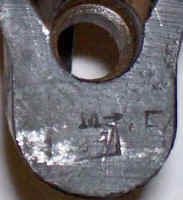 |
3. 1920 Izhevsk Dragoon on 1896 Tula receiver Note the Soviet crest stamped just below the Tsarist eagle.
4. 1921 Izhevsk Dragoon on 1917 Tula receiver The Soviet crest is very faint and the Tsarist eagle is not apparent.
5. 1923 Izhevsk ex-Dragoon (M91/30) on 1895 Sestroryetsk receiver Note the Soviet crest stamped over the Tsarist eagle.
6. 1923 Izhevsk ex-Dragoon (M91/30) on 1917 Tula receiver Note the Soviet crest stamped over the Tsarist eagle.
7. 1926 Tula ex-Dragoon (M91/30) on 1914 Izhevsk receiver Note the Tsarist eagle left in place on the receiver in juxtaposition to the Soviet CCCP mark on the barrel.
8. 1931 Izhevsk M91/30 on 1920 Tula receiver An uncommon case where Izhevsk overstamped the original tang markings with new ones. Pictures courtesy of Chad VanDenBosch.
9. 1937 Tula ex-PE top mount M91/30 sniper on 1936 Tula hex receiver It's possible that this receiver was held over until the next year specifically for use as a sniper before the round PE mount was in full production. At Tula hex receiver production ended and round receiver production began mid year in 1936.
10. 1937 Izhevsk M91/30 on 1926 Izhevsk receiver
11. 1939 Tula ex-PE top mount M91/30 sniper on 1933 Tula receiver
12. 1939 Izhevsk ex-PE top mount M91/30 sniper on 1938 Izhevsk receiver This is probably a case where the receiver was produced late in the year and was not built into a rifle until the next year.
13. 1941 Tula M91/30 on 1941(?) Izhevsk receiver While this rifle is not on an earlier receiver, it is on one from a different arsenal. The last digit of the tang date is not legible, but this type of receiver with the unmachined right rear was only made at Izhevsk from 1941 to 1943. It is unlikely that a 1941 dated barrel would be found on a later receiver so it is reasonable to assume that the receiver was made in 1941. For more information on receiver variations see the Mosin Nagant Rifle Receiver Variations page. It should also be noted that the last digit of the barrel date has been overstamped. The previous digit is not clear, but appears to be a "0". This is logical as it would be unlikely for a barrel to be redated to an older year. Taken as a whole this is a very unusual rifle, especially in light of the scarcity of 1941 Tula M91/30s found in the US. To date this is one of three confirmed among collectors.
14. 1942 Izhevsk M91/30 on Remington receiver The Remington circle R tang mark is overstamped with the Izhevsk arrow in triangle. The large detailed eagle on the top flat is also a Remington hallmark. Pictures courtesy of "Yankee John".
 |
 |
15. 1942 Izhevsk M91/30 on New England Westinghouse receiver While NEW did not mark the underside of the tang it is common to find an inspector's mark on top of the tang. NEW used a variety of letters with an arrow or arrows projecting from them and in this case the E with an arrow is plainly seen. The underside of the tang is marked with the Izhevsk arrow in triangle and not dated. Pictures courtesy of "jp".
 |
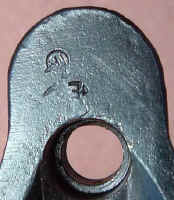 |
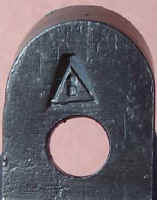 |
16. 1943 Tula M91/30 on Chatellerault receiver Note the elaborate Tsarist eagle on the receiver flat. The tang was not originally arsenal marked or dated but has been restamped with a Tula star and partial "43" date. However, there are marks on each side of the tang which are known Chatellerault marks which make this an antique M91/30.
 |
||
 |
 |
 |
17. 1943 Tula M91/30 on 1928 Tula receiver Note the new date, "43", and the arsenal mark "star" stamped over the old date, "28", and the arsenal mark "hammer". This is the earliest known evidence of restamping the tang with a new date and arsenal mark by Tula.
18. 1943 Tula ex-PU M91/30 sniper on 1942 Izhevsk receiver This rifle is a case where more machining was done by Tula to a receiver originally built at Izhevsk. The original tang date is clearly 1942 and, while faint, the Izhevsk arsenal mark is visible. Further indication that this is an Izhevsk receiver is the continuation of the lug race cut through the threads of the receiver as seen in the upper right picture and the lack of the stepped tang in the middle left picture. At Tula the lug race was not cut through on any production and the tang steps were present until 1943. The further work done by Tula was the machining at the right rear of the receiver as seen in the middle left picture and the addition of the notch forward of the stripper clip guides as seen in the lower left picture. At Izhevsk the right rear was left unmachined from late 1941 to late 1943 and the notch was not present from late 1941 until some time in 1946. This rifle lends credence to Tula's reputation for a higher level of quality and workmanship. For more information on receiver variations see the Mosin Nagant Rifle Receiver Variations page.
19. 1944 Tula M91/30 on 1934 Tula receiver This tang is not restamped with a new date.
20. 1944 Tula M91/30 on 1922 Tula receiver Note the three separate tang stamps highlighted separately in three pictures.
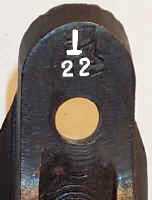 |
 |
 |
|
21. 1944 Tula M38 on 1927 Tula receiver Note the extremely faint Soviet crest on the top flat of the receiver as is typical for Tula rifles from 1927 and 1928.
22. 1944 Tula M38 on 1935 Tula receiver A new star and date have been stamped, but the date is not legible. Apparently the act of restamping was more important than a legible date.
23. 1944 Tula M38 on 1939 Tula round receiver Not only were hex receivers re-used, but the relatively new round receiver design, which began production mid year in 1936, was re-used also. These rebuilt rifles are not as readily apparent as the ones with hex receivers, but a close study of the different receiver variations as explained on the Mosin Nagant Rifle Receiver Variations page will make them easier to identify without removing the action from the stock.
24. 1944 Tula M44 on 1916 Tula receiver
25. 1944 Tula M44 on 1935 Tula receiver
26. 1944 Tula M44 on unknown hex receiver The original date is not legible, but it has been restamped with an incomplete "44" and star. It is possible that this is a New England Westinghouse receiver which were not dated on the tang and did not have an eagle on the top flat.
27. 1944 Tula M44 on 1937 Izhevsk round receiver Note the Tula star and partial "44" stamped over the Izhevsk mark and 1937r date.
28. 1944 Tula M44 on 1938 Izhevsk round receiver
29. 1944 Tula M44 on 1943 Tula receiver This receiver was probably left over from the previous years production rather than reused. It is pictured here to illustrate that it is not uncommon to find barrels dated one year later than receivers.
30. 1944 Tula M44 on Izhevsk receiver of unknown date While the Izhevsk mark is clear on the tang, no original date is evident. The receiver itself fits the pattern of 1943-1944 Tula production. The only difference in these and late 1943-1945 Izhevsk production is the extra notch forward of the stripper clip guide. This notch is usually present only on Tula receivers of this era. See the Mosin Nagant Rifle Receiver Variations page for more information on this. The notch on this example is somewhat crude and it's possible that it was tooled by hand at Tula after delivery of the receiver from Izhevsk. Although technically not an earlier receiver, it is included here because the receiver and barrel have different origins. This M44 is likely an example of the help that was given to Tula when production resumed in it's original location as the Germans were driven back out of the USSR.
31. 1944 Tula M44 on 194? Izhevsk receiver This example is very similar to the one above. Pictures courtesy of "UNBLVR".
 |
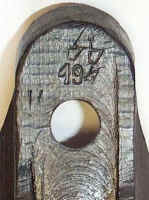 |
 |
32. 1944 Izhevsk M38 on 1941 Izhevsk receiver This is the earliest known wartime use of an older receiver by Izhevsk. Although clearly dated 1941 on the tang, the receiver fits the pattern of 1943-1945 Izhevsk production as shown on the Mosin Nagant Rifle Receiver Variations page. The only difference in these two receiver variations is the machining at the right rear which was probably done when it was rebarreled. This carbine was probably built in late 1944 when there wasn't as much pressure to keep up high production numbers and there was time for the extra machining. As seen below, Izhevsk reused a lot of receivers in 1945 and this is probably the beginning of that pattern. Pictures courtesy of "UNBLVR".
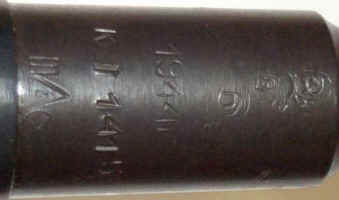 |
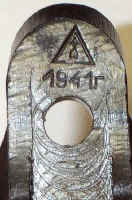 |
 |
|
33. 1945 Izhevsk M44 on 1927 Izhevsk receiver Note that a new date and arsenal mark are not restamped as done at Tula.
34. 1945 Izhevsk M44 on unknown hex receiver It is possible that this is a New England Westinghouse receiver which were not dated on the tang.
35. 1945 Izhevsk M44 on 1937 Tula round receiver This carbine was recognized as having an older receiver because it is a low wall variation with steps at the tang. This type was last built in 1941.
 |
All content copyright |